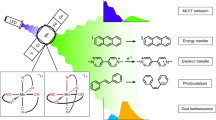Abstract
THE fluorescence of luminophors activated with manganese, and also of pure manganese compounds, is generally attributed to divalent manganese1. The spectra emitted vary between green and red, and the width of the bands also varies from case to case, both probably being dependent on the magnitude and the symmetry of the electric lattice field at the position in the lattice at which the manganese ion is placed.
Similar content being viewed by others
References
Randall, J. T., Proc. Roy. Soc, A, 170, 272 (1939). Kröger, F. A., Physica, 6, 764 (1939); Dissertation, Amsterdam, 1940. The arguments brought forward by Uehara, Y., J. Chem. Soc Japan, 61, 741 (1940), in favour of atomic manganese, are not very convincing.
The same applies also to manganese-activated strontium aluminates which have recently been patented (Froelich, H. C, U.S.A. Pat, 2,392,814).
Deutschbein, O., Phys. Z., 33, 874 (1932).
Such a resemblance has been observed between the absorption bands of Sm2+ and Eu3+. Butement, F. D. S., and Terrey, H., J. Chem. Soc, 1112 (1937).
Kröger, F. A. "Some Aspects of the Luminescence of Solids" (Elsevier Publishing Co., Amsterdam and New York, 1947), in the press.
Author information
Authors and Affiliations
Rights and permissions
About this article
Cite this article
KRÖGER, F. Tetravalent Manganese as an Activator in Luminescence. Nature 159, 706–707 (1947). https://doi.org/10.1038/159706b0
Issue Date:
DOI: https://doi.org/10.1038/159706b0
- Springer Nature Limited
This article is cited by
-
Some aspects of the activation of phosphors by tetravalent manganese
Acta Physica Academiae Scientiarum Hungaricae (1962)




